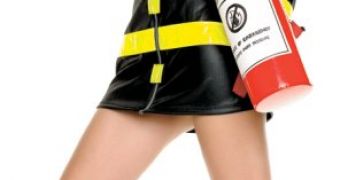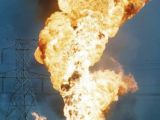Fire is the biggest destroyer of human life and goods. Now the ultimate technologies fights against it. Conventional firemen cars for putting out building fires are endowed with tanks of 1,365 liters of water and telescopic stairs with a length of 9-15 m (30-50 ft). This water is used only when there is no other source.
As soon as they arrive, the firemen look for a faucet for connecting to a water conduct. In rural areas, the water can be pumped from a well or lake. A conventional intervention car can pump up to 4,000 liters of water per minute. All firemen vehicles around the world are red, to be easy to spot.
The stairs on rotative support can be up to 33 m (110 ft) long and can be rotated. This way, firemen save people from tall buildings or put out fires in this type of buildings. Sometimes, instead of a stair, a platform mounted on a long hydraulic arm is used; the platform has a maximum capacity for 4 people. The hose is fixed on the platform, being acted by one of the firemen on the platform or one found in the car.
Amongst the accompanying cars, there are some endowed with foam extinguishers, units responsible for coordinating the intervention but also cars carrying cutting tools, pulleys, and powder extinguishers, employed for putting out fires in which water cannot be safely used.
The burning requires fuel, heat and oxygen. By pouring water on the fire, this will cool down the burning stuff, decreasing the fire's temperature and extinguishing its flames. Jet pressure splashing also floods the burning materials. But water is not always effective: burning gasoline or petroleum floats over water. Using water for putting out electric fires is risky, as the firemen can be electrocuted by the water jet. And some metals burn faster if put in contact with the water.
Fires caused by inflammable liquids (gasoline or petroleum) are usually put out using foam. Liquid foam mixes with air while passing through the hose and the foam can gush up to 20 m (66 ft) in height. Some firemen vehicles can contain huge ventilators, that disperse the foam for covering inaccessible surfaces.
Traditional foam is dense and heavy. It is effective, but it does not spread over large areas and it runs slowly through the hose.
Surface foam is light and spreads well over liquid surfaces, but it cannot be spread to large distances, exposing the fireman to a closer contact to the hotbed.
Water light foams are used for extinguishing inflammable vapors. They are a mix of water, synthetic chemicals with surface action and fluorinated hydrocarbons and leave a tin layer on the surface of the fuel. They impede the reburst of the fire.
Highly extensible foam is the best for putting out fires in closed spaces (like tunnels or ship rooms).
These techniques cannot fight fire forests. For example, in 1982, 13,500 square km (5,000 square mi) of forest were destroyed in Borneo by a sole fire. The fire took place for 10 months, till the arrival of the rainy season.
Also the fires in the oil wells are extremely hard to stop. One method is to blow up the surface structure of the well; the flames are relented with water. At the base of the crane are fixed some grenades with gelignite. The blow will create an extremely powerful air current, which will spread out gases and oxygen, cutting off the factors feeding the fire. This is hard to do, as the flames spread toxic gases, containing hydrocarbons, sulfur dioxide, nitrogen oxides and lead particles.
But this cannot be applied to marine wells. These fires are put out using powerful jets of sea water, pumped by special ships.
Today, softwares can help firemen to simulate fires depending on furniture and architecture, so that they can choose the right intervention strategy.
Extinguishes based on carbon dioxide or halon can be used against inflammable liquids and gases and electric fires.
Electric fires are also put out using liquids which can be pulverized. They do not conduct the electric current, so that the firemen are not electrocuted and installations destroyed. Dry powders do not leave air for the flames and are used when there are inflammable liquids. Most of these powders contain sodium bicarbonate, but some are based on black lead or talc. The last ones are used for extinguishing burning metals. There are dry powders designed for fires comprising radioactive metals, like the uranium.
During the Cernobyl fire, in 1986, the temperature raised to 2,700o C, turning the water in a few moments into radioactive vapors that covered the firemen. The fire was put out only after the spread from helicopters of over 5,000 tonnes of sand, clay, lead and boron.
The fireman suit is made of asbestos sheathed with an aluminum layer. This suit is resistant to flames and rejects heat. The facial masks have similar traits.
The value of a fireman is given by physical training, team work, self confidence and especially courage, as this job implies huge life threatening risks.

 14 DAY TRIAL //
14 DAY TRIAL // 
